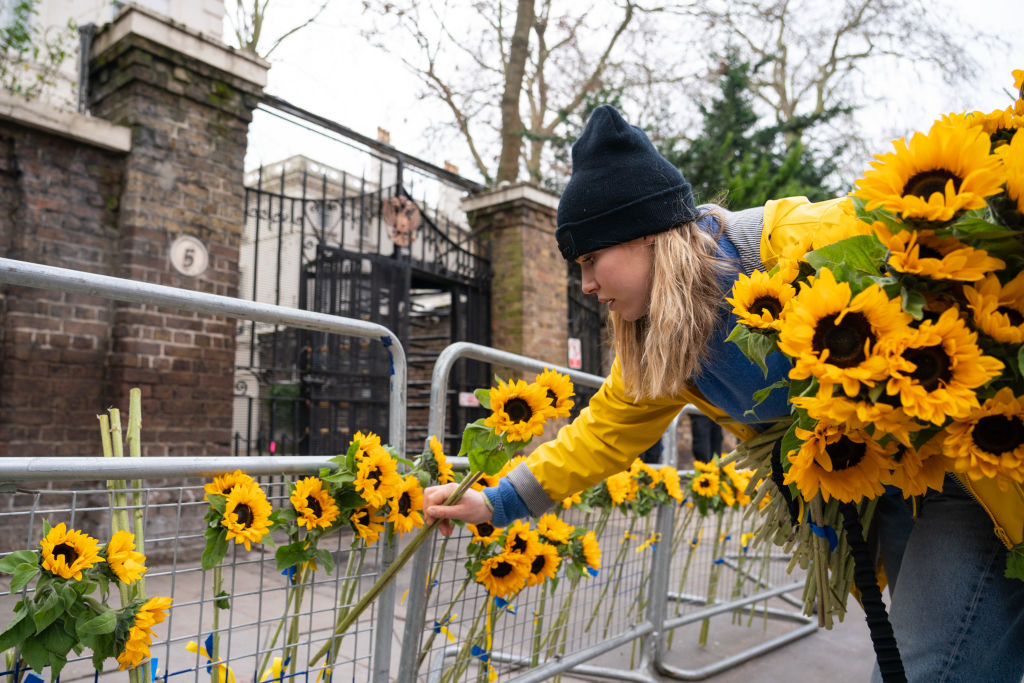
As the Russian invasion of Ukraine has continued over the past week, displaying sunflowers has become one of the many ways the world is showing solidarity for the Ukrainian people.
At the State of the Union on Tuesday night, First Lady Jill Biden wore a dress with a sunflower sewn-in on the right sleeve. From Mexico City to Caracas, protesters held up sunflowers as they took to the street to condemn Russia’s actions. In London, sunflowers poke out of the barricades in front of the building housing Sunflowers for Peace, a charity organizing aid for Ukrainian residents, while in Reno, Nev., they emerge from a public art piece that spells out “BELIEVE.”
Globally, awareness of the association between sunflowers and Ukraine has grown since Feb. 24, the first day of the invasion, when the news outlet Ukraine World shared a video on Twitter showing a Ukrainian woman in Henychesk giving sunflower seeds to Russian soldiers, with the striking instruction to put the seeds in their pockets so the flowers will grow where they die. The video has racked up 8.6 million views on Twitter since it was uploaded on Feb. 24, and comedian John Oliver featured it on Last Week Tonight.
Read More: ‘We Will Defend Ourselves.’ Photographs of Ukraine Under Attack
But the flower has an even longer history in the country. Sunflowers—soniashnyk in Ukrainian—have been grown in Ukraine since the mid-18th century, according to a 1993 Encyclopedia of Ukraine. At the time of the book’s publication, sunflower seeds were the country’s most popular snack. The flower also helps fuel the national economy today; Ukraine and Russia supply up to 70–80% of the world’s sunflower oil exports.
“The ubiquitous presence of the sunflower in the villages and countryside of Ukraine has made it an unofficial national symbol,” the encyclopedia says.
Throughout Ukraine’s history, the flower has been used as a symbol of peace. In June 1996, to celebrate Ukraine giving up nuclear weapons, U.S., Russian and Ukrainian defense ministers planted sunflowers in a ceremony at southern Ukraine’s Pervomaysk missile base.
“The ceremony celebrated Ukraine’s abandonment of the world’s third-largest nuclear arsenal, which it inherited in the 1991 collapse of the Soviet Union,” the Washington Post reported back then. “It also marked the near completion of a primary U.S. strategic goal since the Soviet breakup: to gather all ex-Soviet nuclear weapons in Russia, thus avoiding a proliferation of nuclear powers.”
More than 25 years after that ceremony, Russian and Ukrainian ministers are at war, but the meaning of the sunflowers as symbols of peace has not changed, as the cropping up of sunflowers worldwide has become a call on leaders to plant the seeds again for a more peaceful future.
With reporting by Abby Vesoulis
More Must-Reads from TIME
- Cybersecurity Experts Are Sounding the Alarm on DOGE
- Meet the 2025 Women of the Year
- The Harsh Truth About Disability Inclusion
- Why Do More Young Adults Have Cancer?
- Colman Domingo Leads With Radical Love
- How to Get Better at Doing Things Alone
- Michelle Zauner Stares Down the Darkness
Write to Olivia B. Waxman at olivia.waxman@time.com